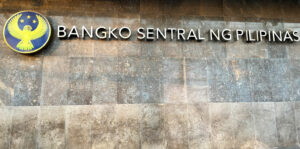




Philippines Trade Update: Trade trajectories trend along
 DOWNLOAD
DOWNLOAD

Policy Rate Updates: Double cut finale
 DOWNLOAD
DOWNLOAD

Monthly Economic Update: One for the road
 DOWNLOAD
DOWNLOAD


Easing cycle still underway — BSP

CEBU — The Philippine central bank’s easing cycle is still underway though it may opt to keep rates steady at its December meeting, its top official said.
“We’re still in the easing cycle. Either we cut in December, or we cut in the next meeting, but gradually,” Bangko Sentral ng Pilipinas (BSP) Governor Eli M. Remolona, Jr. told reporters on the sidelines of the BSP-International Monetary Fund (IMF) Systemic Risk Dialogue in Mactan, Cebu on Tuesday.
Asked if the central bank could keep interest rates steady at its December meeting, Mr. Remolona said in mixed English and Filipino: “Yes, of course. It depends on the data. We are still not sure about December.”
Mr. Remolona reiterated that the central bank will continue to make rate cuts in 25-basis-point (bp) increments.
He earlier said the BSP may not necessarily reduce rates at every quarter or every meeting.
Since it began its easing cycle in August, the BSP has reduced borrowing costs by a total of 50 bps so far.
The Monetary Board has delivered a 25-bp cut at its meetings in August and October, bringing the benchmark to 6%.
Mr. Remolona had earlier signaled the possibility of a 25-bp cut on Dec. 19, the Monetary Board’s final policy meeting this year.
Meanwhile, he said the weak gross domestic product (GDP) growth in the third quarter was likely an “aberration” and that growth would likely recover in the fourth quarter.
The Philippine economy grew by a weaker-than-expected 5.2% in the third quarter, its slowest growth in five quarters.
This brought GDP growth in the nine-month period to 5.8%. The economy needs to grow by at least 6.5% in the fourth quarter to ensure it can hit the low end of the government’s 6-7% full-year target.
Instead, the central bank is monitoring closely the latest inflation data, Mr. Remolona said.
“The next number to expect is the November inflation number, we’ll see what that is. Our expectation is that it will still be within the target band.”
Headline inflation picked up to 2.3% in October, bringing the 10-month average to 3.3%. This was still within the BSP’s 2-4% target range.
For 2025, the BSP chief said that the Monetary Board could likely deliver rate cuts at the 100-bp range.
“That’s not exact. It could be more, could be less, but that’s in the ballpark,” he added.
Peso performance
Meanwhile, the BSP governor said he is not worried about the peso’s recent performance.
“It’s below PHP 59. We don’t worry so much about whether the peso depreciates, appreciates. We worry about the pass-through effect. Right now, it’s still okay,” Mr. Remolona said.
The peso closed at PHP 58.81 per dollar on Tuesday, depreciating by 13 centavos from its PHP 58.68 finish on Monday, Bankers Association of the Philippines data showed.
Markets are keeping an eye out for whether the peso will sink to the P59-per-dollar level. The peso fell to the record low of PHP 59 per dollar in October 2022.
However, he said the central bank has been intervening in “small amounts.” “A little bit just so it won’t (depreciate sharply against the dollar),” he said.
“We leave it to the guys in the financial markets area, but if it depreciates very sharply, then we talk. If it’s not too sharp, it doesn’t become inflationary. It’s inflationary if it’s sharp and persistent.”
He said the recent peso weakness was expected after Donald J. Trump was elected US president. The US dollar has been on the rise amid market expectations Mr. Trump would implement higher tariffs that could fuel inflation and slow the Federal Reserve’s planned rate cuts.
“We monitor the swings that take place over a few months, not day by day. It is usually expected that the night before, this kind of news will put pressure on the peso.” – Luisa Maria Jacinta C. Jocson, Reporter
This article originally appeared on bworldonline.com





 By BusinessWorld
By BusinessWorld